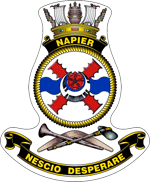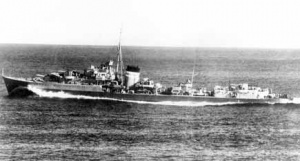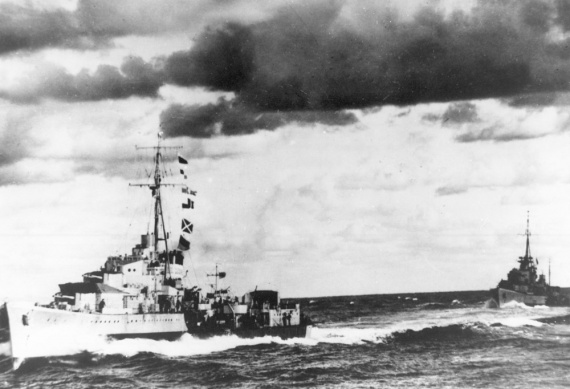HMAS Napier
| Class |
N Class |
|---|---|
| Type |
Destroyer |
| Pennant |
G97 |
| Builder |
Fairfield Shipbuilding & Engineering Co Ltd, Scotland |
| Laid Down |
26 July 1939 |
| Launched |
22 May 1940 |
| Commissioned |
28 November 1940 |
| Decommissioned |
25 October 1945 |
| Dimensions & Displacement | |
| Displacement |
|
| Length | 356 feet 6 inches |
| Beam | 35 feet 8 inches |
| Draught | 16 feet 4 inches |
| Performance | |
| Speed | 36 knots |
| Complement | |
| Crew | 226 |
| Propulsion | |
| Machinery | Parsons geared turbines |
| Horsepower | 40,000 |
| Armament | |
| Guns |
|
| Torpedoes | 10 x 21-inch torpedo tubes (2 pentad mounts) |
| Other Armament |
|
| Awards | |
| Battle Honours | |

HMAS Napier was one of eight N Class destroyers laid down in British yards during 1939 to the order of the Royal Navy. Five (Napier, Nestor, Nepal, Nizam and Norman (I)) were transferred to the Royal Australian Navy, two to the Royal Netherlands Navy and one to the Polish Navy. The only one to become a war loss, HMAS Nestor, was sunk by air attack in the Mediterranean on 16 June 1942.
Napier commissioned on the Clyde on 28 November 1940 under the command of Captain Stephen Arliss RN, a well known Royal Navy destroyer Commander and Captain (D) of a peace time Mediterranean Flotilla. His staff consisted of Australian officers with a nucleus of Royal Navy officers and her company was entirely drawn from the Royal Australian Navy.
Trials and working up at Scapa Flow was followed by a period of uneventful North Atlantic convoy protection duty, before transferring to the Mediterranean to bolster the hard pressed destroyer units operating in that theatre. Napier in company of her sister ship HMAS Nizam arrived shortly before the evacuation of Crete began in May 1941. Here she suffered her first attentions from the enemy, when screening a Mediterranean convoy. She experienced a near miss from a heavy bomb.
Later in May 1941 she assumed duty on the screen of the battle fleet operating south and east of Crete. The battle for the island lost, Napier became one of the units charged with the responsibility of evacuating the British forces.
On 28 May 1941 Napier (Captain (D), 7th Destroyer Flotilla), Nizam and HM Ships Kelvin and Kandahar, left Alexandria for Crete, arriving safely at Sphakia after an uneventful run. In the early hours of the following morning, Napier embarked 296 soldiers, three women, one Greek and Chinese national, ten seamen, two children and a dog.
At 3:00am the entire force sailed on the return voyage. It proved more hazardous and though Napier escaped, Nizam was damaged by several near misses. On the morning of 30 May the four destroyers again sailed for Crete. Two were forced to return; Kandahar, because of engine trouble; and Kelvin as a result of damage sustained under air attack. The two Australian ships continued to Crete to try and evacuate numbers intended to be borne in four ships. At 2:30am the following morning Nizam left Crete carrying 698 troops. Half an hour later Napier sailed with 705 soldiers, mostly Australians.
At 9:00am the expected air attacks developed when twelve planes made a determined attempt to sink Napier. Two sticks each of eight bombs fell on her port side and across her stern. Fourteen were classed as near misses. Damage to her engine and boiler rooms reduced speed to twenty knots. The attackers did not escape unscathed from the intense anti-aircraft fire and in the words of Napier's Commanding Officer, 'One Ju.88 was certainly shot down and it is considered three others were damaged.' In spite of her hazardous passage no life was lost and all troops were safely landed at Alexandria.
The next two-and-a-half months, June to August 1941, were spent at Port Said making good damage defects. The destroyer however was not entirely idle. She was designated control ship for harbour air defence. On the night following her berthing, Port Said suffered its first air raid. Eleven bombs fell nearby, but she escaped further damage from this and repeated subsequent heavier raids.
Refitting completed she assumed duty in August 1941 as leader of the 7th Flotilla which included among others, destroyers well known for their Mediterranean service, HM Ships Jaguar, Jackal, Javelin and Kingston.
In the closing months of 1941 Napier took part in the supplying of besieged Tobruk in September, gave protection to Mediterranean and Red Sea convoys and served on the screen of the fleet at sea. She was one of the screening destroyers when HMS Barham was torpedoed and sunk on 25 November 1941. In November also she took part with nine other destroyers in the transfer of troops from Haifa to Cyprus and vice versa. On 30 December 1941 she sailed from Alexandria as one of the destroyers escorting the heavy ships for the bombardment of Bardia, in Libya, prior to its capture by the 8th Army.
In January 1942 Napier, with Nizam and Nestor in company, left the Mediterranean Theatre to enter the Indian Ocean. On reaching Aden the three destroyers were ordered to join and escort the aircraft carrier HMS Indomitable to ferry aircraft reinforcements for the Malayan/Java theatre. The operation successfully concluded, the carrier and her escort proceeded to Port Soudan for a second flight of planes. Too late to land them in the Malayan theatre as Singapore had fallen, they were flown off some 100 miles from Colombo in time to take part in the successful defence of that port against a first Japanese air attack.
Parting from Indomitable, Napier proceeded to Trincomalee and there became a unit of the Royal Navy's Eastern Fleet. The period of February to May 1942 was spent in the Indian Ocean. It was an uneventful period for Napier, taken up by escort duties, patrols and as a unit on the screen supporting the heavy ships on operations out of Trincomalee.
In June 1942 Napier returned for a brief period to the Mediterranean as one of the escorting destroyers for a large scale Alexandria to Malta convoy. Napier's sister ship HMAS Nestor, also one of the escorting destroyers, was lost during passage of the convoy.
Returning to the Indian Ocean, Napier rejoined the Eastern Fleet and again took up Indian Ocean patrol and escort duties. In September 1942 the destroyer took part in the closing stages of the Madagascan campaign. She was present at the surrender of Majunga on 10 September and again at the occupation of Tamatave on 18 September. The closing months of 1942 were all spent based on Kilindini, on escort and patrol duty between the fleet base and Durban. It was an uneventful period. Lieutenant Commander Arnold Green DSC RAN assumed command from Captain Arliss on 7 November 1942.
The year of 1943 opened with Napier at Durban, still occupied on patrols and escort in the East Indian Ocean and the Mozambique Channel. In late March 1943 she joined the South African anti-submarine forces and spent the following two months operating on the South Atlantic Station. In June the destroyer again began Kilindini to Durban patrols and escort duty. In October 1943 Napier began escorting convoys from Africa to Aden and Bombay and continued these operations until the close of the year.
On 1 January 1944 Napier left Aden for the re-opened Royal Navy base at Trincomalee, and thereafter remained with the Eastern Fleet attached to that base. The first three months of the year were spent in Indian waters, exercising with the fleet and on patrol and escort duties. In March 1944 Napier operated with the fleet in the Bay of Bengal.
On 19 April Napier, wearing the broad pendant of Commodore Arliss DSO, RN (Commander (D) Eastern Fleet), and four other Australian destroyers, operated on the screen protecting the carriers USS Saratoga and HMS Illustrious for the attack on the Japanese held port of Sabang in Sumatra. The following month, on 17 May 1944, Napier took part in the strike by the same two carriers against Surabaya in Java.
On 4 June 1944 the pendant of Commodore Arliss was struck in Napier and that of Commodore AL Poland CB, DSO, DSC, RN was hoisted as Commodore (D) Eastern Fleet. On 7 July her role as fleet destroyer leader ended at Colombo and a week later she finally detached from the Eastern Fleet off Trincomalee. On 27 July Napier entered Fremantle.
A long refit at Melbourne followed, ending when the ship sailed for Fremantle under the command of Lieutenant Commander J Plunkett-Cole, RAN, and thence proceeded to Trincomalee on 21 October 1944 to rejoin the Eastern Fleet, arriving at the fleet base on 1 November. The following day Captain HJ Buchanan, DSO, RAN assumed command as Captain (D) 7th Destroyer Flotilla and Napier resumed her role as a leader of Eastern Fleet destroyers. The month was spent mostly at Trincomalee with one run to Bombay screening the carrier HMS Victorious.
On 6 December 1944 Napier arrived at Chittagong in India preparatory to proceeding up the Mayer Peninsula to give bombardment support to the 74th Indian Brigade operating against the Japanese forces. The bombardments continued to the close of the month, Napier alternating with her sister ship HMAS Nepal, running to Chittagong every three days for stores and ammunition.
In January 1945 Napier played a leading part in further Burma operations, including the capture of Akyab Island on 3 January and operations at Ramree Island on 21 January, when she effectively silenced Japanese shore batteries with her 4.7-inch fire. She returned to Colombo at the close of the month to make preparation for joining forces with the British Pacific Fleet.
On 22 February she proceeded for Fremantle escorting the carrier Formidable. En route a wide but unsuccessful search was carried out in an effort to locate survivors of the torpedoed American merchant vessel Peter Sylvester.
On 1 April Napier, Norman (I) and Nizam proceeded in company for Manus Island, arriving on 7 April. The same month she arrived in the Philippines, attached to the British Pacific Fleet and the following month operated on the screen of the Fleet Carriers attacking Sakishima as part of the Okinawa Campaign.
During the final stages of the Pacific War, Napier continued to operate on the screen of the task forces carrying out air strikes against the Japanese mainland. When hostilities ended on 15 August 1945 Napier was still at sea with the combined American and British strike forces.
With her sister ship Nizam in company she anchored in Tokyo Bay at noon on 30 August 1945 and was present for the formal Japanese surrender. After taking part in the occupation landings, she sailed for Sydney, arriving on 22 September 1945. The following month Napier reverted to the Royal Navy, bringing to a close five years service with the Royal Australia Navy during the course of which she steamed more than 270,000 miles.
Further reading
- 'The Historical Background to the 'N' Class Destroyers Story' by Ken Cunningham.
- 'N Class: The Story of HMA Ships Napier, Nizam, Nestor, Norman & Nepal' by LJ Lind and MA Payne - published by Naval Historical Society of Australia, Garden Island, 1974.







